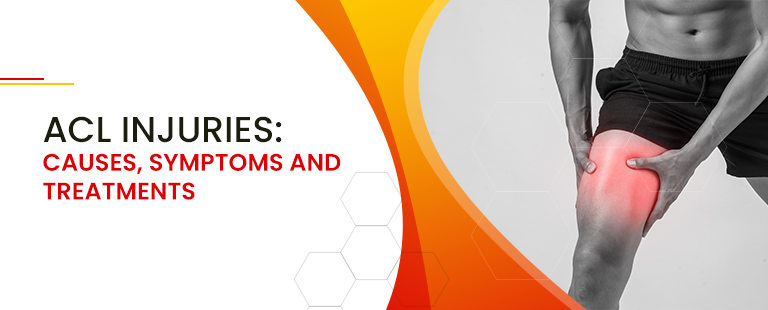ACL Injuries: Causes, Symptoms and Treatments
ACL Injuries: Causes, Symptoms and Treatments
An ACL (anterior cruciate ligament) tear is one of the most common knee injuries. It is more common in athletes who engage in high-demand sports such as basketball, soccer and football.
Anatomy of the knee joint
The knee joint is composed of three bones – the thigh bone, kneecap and shinbone. The kneecap is situated in front of the joint for protection. These bones are connected by four primary ligaments to hold the knee stable. The two types of ligaments that are located in the knee joint are collateral ligaments and cruciate ligaments. The collateral ligaments are located on the sides of the knee. These ligaments are responsible for protecting the knee from unusual movement. On the inside, the ligament is called medial collateral ligament whereas the ligament located on the outside is called a lateral collateral ligament. The sideways motion of the knee is controlled by the collateral ligaments.
The ligaments found inside the knee joint are called cruciate ligaments. These ligaments form an “X” shape. The posterior cruciate ligament is located in the back and the anterior cruciate ligament is located in the front. The back and forth motion of the knee is controlled by the cruciate ligaments. The anterior cruciate ligament provides rotational stability to the knee and prevents the tibia from sliding out in front of the femur.
Injuries in the anterior cruciate ligament are called “sprains” and are graded on a scale of severity of the injury.
- Grade 1 Sprains – A mild injury of the ligament is known as Grade 1 sprains.In this type of injury, the ligament has been slightly stretched but it is still able to keep the knee joint stable.
- Grade 2 Sprains – Also known as a partial ligament tear, in this type of injury,
the ligament gets stretched to the point where it becomes loose. - Grade 3 Sprains – A complete tear of the ligament where it gets split into two
pieces is called a Grade 3 sprain. With this kind of injury, the knee joint
becomes unstable. This is the most common type of ACL injury.
Causes
There are various reasons behind an ACL tear:
- Collision or direct contact, such as a football tackle
- Stopping suddenly
- Rapidly changing direction
- Suddenly slowing down while running
- Incorrect landing from a jump
Female athletes are more prone to get ACL injuries, as compared to male athletes while playing certain sports. Studies say that this is due to the differences in muscular strength, neuromuscular control, physical conditioning, increased looseness in ligaments, the effect of estrogen on ligament properties and pelvis and lower leg alignment.
Symptoms of ACL injury
The most evident symptom of an ACL tear is a popping sound. You would feel your knee giving out from under you. A few other symptoms of an ACL injury include:
- Pain
- Swelling within 24 hours of injury
- Loss of mobility
- Discomfort while walking
- Tenderness along the joint line
If the pain and swelling are ignored, it might resolve on its own. However, if an individual tries to return to sports immediately after an ACL injury, the meniscus of the knee might get damaged.
Diagnosis
treatment. During your first visit to Germanten after an ACL tear, the doctor will first talk to you about your medical history and symptoms. Then, your doctor will perform a physical exam wherein he or she will check all the structures of your injured knee and compare it with your non-injured knee. Most of the time, a physical exam is enough to diagnose a ligament injury. To confirm this diagnosis, the doctors at Germanten might perform imaging tests such as an MRI or an X-ray.
Treatment
Usually, a torn ACL cannot be repaired without surgery however in some cases, nonsurgical treatments might be effective. Nonsurgical treatments include bracing and physical therapy. These methods are suggested for patients who have a very low activity level or are older.
Surgical treatment for an ACL tear includes reconstruction of the ligament, as ACL tears cannot be repaired by suturing the ligament back together. The torn ligament is replaced with a tissue graft, on which the new ligament grows. This tissue graft is generally extracted from the patellar tendon or the hamstring tendons. An arthroscope is used to perform the surgery as it is a minimally invasive technique. At Germanten Hospital, the most advanced and sophisticated medical equipment and technologies are used to perform minimally invasive surgeries. Each operation theatre has a highly advanced laminar airflow for total infection control. Germanten Hospital has been accredited with NABH (National Accreditation Board for Hospitals & Healthcare). With more than 200 beds, we aim to provide excellent care and service to our patients. Germanten Hospital was named the Best Orthopedic Hospital in South India by Economic Times in 2021. In 2019, Times of India graded it as the Best Emerging Orthopedic Hospital. Create a balance between strength and flexibility.
Reconstructive surgery at Germanten Hospital is performed by a team of expert doctors, led by Dr.Mir Jawad Zar Khan. A veteran of more than 20 years in the field of orthopaedics, he has performed more than 10000 surgeries. Dr.Mir Jawad Zar Khan was awarded the title of Best Doctor by the ex-CM of Joint Andhra Pradesh & Former Governor Tamilnadu, Shri Roshaiah Garu in 2018. In 2019, he was honoured with the Vaida Ratna Award by the Honourable Health Minister of Telangana, Shree Etala Rajendra.


